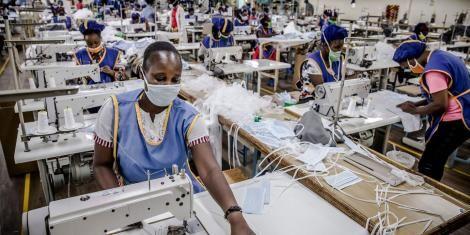By Faridah N Kulumba
Africa-Press – Kenya. Kenyan Association of Manufacturers (KAM) chairperson Mucai Kuniha confirmed last week that the real Kenya shilling exchange rate against the United States dollar rose above sh12o even though it is formally quoted at around sh116.
Repercussions
According to him although the formally quoted exchange rate for the US dollar in the market is hovering around sh115-sh116 none of the members can access currency at that price in the market. Some supplies have already been cut or delayed as a lot of manufacturers have breached suppliers’ credit limits, a situation that might affect trade insurance in the future.
Survival of the fittest
Businesses in Kenya now struggling to raise enough dollars at a higher cost to facilitate essential foreign trade transactions such as raw material importation and Information Technology (IT) services. Several importers are behind their order schedule for a lack of US currency, a move likely to cause a shortage of commodities in the market.
Straining relationships
The concern by the manufacturer confirms revelation by US lender JP Morgan which on March 22 issued a client alert saying that it was straining to finalize some client transactions in Kenya due to dollar liquidity. The US dollar shortage situation is already straining relationships with external suppliers. Two weeks ago, Equity had a wire limit of USD20,000, however within a week not even USD10,000 was available. Businesses are now forced to accumulate dollars for a number of days to meet payments.
Liquidity constraints cause
Liquidity led to high petroleum and food import costs which attributed to the ongoing war between Russia and Ukraine which resulted in the straining of the country’s forex chest. Bankers have also attributed the liquidity pain to increased outflows for dividend payments to foreign investors at Kenya’s Securities Exchange (NSE) #ticker: NSE.
Ukraine-Rusia effects
As the countries are still struggling with the Covind-19 pandemic effects since the year 2020, the world is now faced with a great crisis that seems to dwarf all others since the second world war the Russia-Ukraine conflict. On 21 March, the government of Kenya revealed that the ongoing war in Ukraine will affect the economic growth of the country. The months-long war broke out in Ukraine after Russia invaded Ukraine. The Kenyan government said that the war is disrupting the export-import supply chain which could especially affect fuel prices. The increase in fuel prices will touch nearly every service delivered and each product produced and distributed.
Russia-Ukraine contribution to Kenya
Russia and Ukraine bear significant contributions to Kenya’s economy due to the fact that both nations carry a huge percentage of wheat production in the world. Russia contributes 10 percent while Ukraine is 4 percent. Kenya finds itself in this geopolitical conundrum that adversely affects the global agricultural market since Kenya imports a great deal of wheat from the two countries. In 2019, wheat importation from Russia and Ukraine stood at Ksh,11 billion and Ksh,5 billion respectively.
Worries
The country is already prone to face strain as many funds from public coffers somehow find their way for usage on the campaign trail. It leaves little funds flowing into local citizens’ pockets for expenditure, much less to pump into savings and investments. Kenyans are set to cast their votes on 9th August this year. The hot race is between the number two in power Deputy President William Ruto and the leader of the opposition Raila Odinga for the Orange Democratic Movement (ODM) who was endorsed by Kenyan President Uhuru Kenyatta. For many Kenyans, this will be the mother of all elections.
Dollar shortage implications
The liquidity constraints may result in delayed execution and completion of foreign exchange transactions. This situation is compounded by the weakening of the Kenyan shilling against the dollar, which means that it is costing companies a lot to buy forex. It has meant that firms are holding against further weakening by stocking up on dollars or holding on tightly to their greenback reserve.
The shilling was exchanging at an average of 115.46 units to the dollar last week, having depreciated by 2.1 percent this year. Demand for the dollar has gone up significantly this year in line with surging imports following the full reopening of the economy, which has unleashed pent-up demand for both consumer and capital goods.
For More News And Analysis About Kenya Follow Africa-Press






